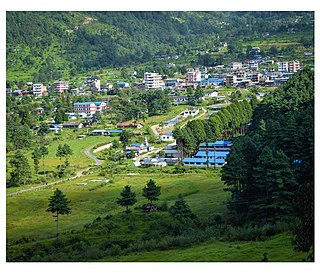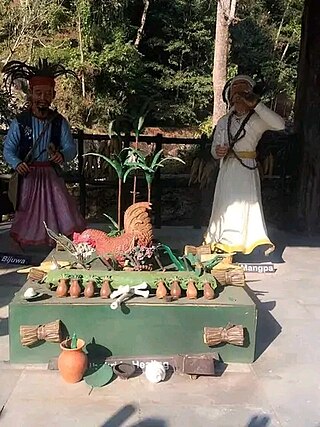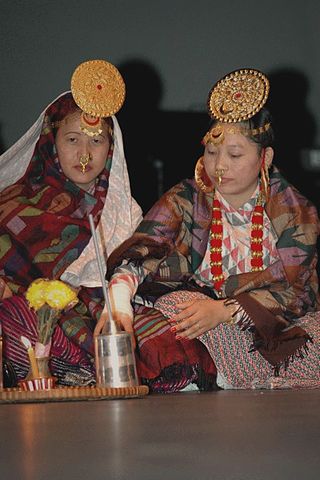Related Research Articles

Nepal is a multi-ethnic, multiracial, multicultural, multi-religious, and multilingual country. The most spoken language is Nepali followed by several other ethnic languages.

Jiri is a municipality in Dolakha District in the Bagmati Province of central Nepal. At the time of the 2011 Nepal census it had a population of 13,638 people. Jiri, which lies about 190 kilometers from Kathmandu, is the main gateway to the Everest Region. Almost all the Everest expeditions, including the one led by famous climber John Hunt, Edmund Hillary had passed through Jiri. A company of the Nepal Army is stationed in town and visitors' equipment and backpacks might be searched. There are a number of lodges available along either side of the main road mainly in Jiri Bazaar.

The Rai also known as Khambu and Jimee are ethnolinguistic group belonging to the Kirat family and primarily Tibeto-Burman linguistic ethnicity. They mainly reside in the eastern parts of Nepal, the Indian states of Sikkim, West Bengal and in southwestern Bhutan.

Yakkha or Dewan is an indigenous ethnic group from the Indian subcontinent, mainly in modern-day Nepal and present-day India. It is one of the descendants of Nepal's prehistoric Kirat dynasty. The Yakkha people are subsistence farmers who inhabit the lower Arun valley in eastern Nepal. They number only a few thousand and their language is nearly extinct.

Bhojpur is one of the two urban municipalities of Bhojpur District of Province No. 1 of Nepal.

The history of Sikkim begins with the indigenous Lepcha's contact with early Tibetan settlers. Historically, Sikkim was a sovereign Monarchical State in the eastern Himalayas. Later a protectorate of India followed by a merger with India and official recognition as a state of India. Lepchas were the main inhabitants as well as the Rulers of the land up to 1641. Lepchas are generally considered to be the first people, Indigenous to Sikkim also includes Darjeeling.

Iman Singh Chemjong Limbu; was a Limbu historian, writer, linguist, lexicographer, folklorist, and philosopher of Nepal. Chemjong devoted his entire life to studying and documenting various facets of Kirat Limbu tradition and culture at a time when such activities were frowned upon and even punished by the Nepalese ruling elite as being subversive and "anti-national". Chemjong's research into and publication of Kirant history and culture challenged perceptions of the Nepalese official doctrine that showcased Nepal as a Hindu cultural monolith devoid of alternative narratives.

Religion in Nepal encompasses a wide diversity of groups and beliefs. Nepal is a secular nation and secularism in Nepal under the Interim constitution is defined as "Religious and cultural freedom along with the protection of religion and culture handed down from time immemorial." That is, "The state government is bound for protecting and fostering Hindu religion while maintaining "Religious" and "Cultural" freedom throughout the nation as fundamental rights.

The Kirati people, also spelled as Kirant or Kiranti, are Sino-Tibetan ethnolinguistic groups living in the Himalayas, mostly the Eastern Himalaya extending eastward from Nepal to North East India.
The Bantawa Language, is a Kiranti language spoken in the eastern Himalayan hills of eastern Nepal by Kirati Bantawa ethnic groups. They use a syllabic alphabet system known as Kirat Rai. Among the Khambu or Rai people of Eastern Nepal, Sikkim, Darjeeling and Kalimpong in India, Bantawa is the largest language spoken. According to the 2001 National Census, at least 1.63% of the Nepal's total population speaks Bantawa. About 370,000 speak Bantawa Language mostly in eastern hilly regions of Nepal (2001). Although Bantawa is among the more widely used variety of the Bantawa language, it falls in the below-100,000 category of endangered languages. It is experiencing language shift to Nepali, especially in the northern region.

Kirat Mundhum, also known as Kiratism, or Kirati Mundhum, is a traditional belief of the Kirati ethnic groups of Nepal, Darjeeling and Sikkim, majorly practiced by Yakkha, Limbu, Sunuwar, Rai, Thami, Jirel, Hayu and Surel peoples in the north-eastern Indian subcontinent. The practice is also known as Kirat Veda, Kirat-Ko Veda or Kirat Ko Ved. According to some scholars, such as Tom Woodhatch, it is a blend of shamanism, animism, and Shaivism. It is practiced by about 3.17% of the Nepali population as of 2021.

The Mundhum is the ancient religious scripture and folk literature of the Kirat people. It is an ancient, indigenous religion of Nepal. Mundhum means "the power of great strength" in the Limbu language. The Mundhum covers many aspects of the yakthung (Limbu) culture, customs and traditions that were followed since before the rise of the Vedic civilisation in the Indian subcontinent.
Yelam Sambat is the lunar calendar used by the Kirat community of Nepal. The Yelam Sambat calendar is named after the first Kirat king Yalambar. The Limbus call it Yele Tangbe, Yakkha (Dewan)s call it Yele Naamsam, the Rais call it Yele Dong, and the Sunuwars call it Yele Thoche.

Udhauli (उधौली) is a festival of the Kirat communities of Kirati people specially celebrated by Sunuwar, Limbu, Yakkha, Khambu Rai etc. of Nepal, India and other different countries around the world where these indigenous people resides. It is celebrated every year marking the migration phase downwards towards the low-elevation regions when the winter season arrives. The migration from the low-elevation areas upwards to hilly areas is called Ubhauli (upwards), which is also an annual festival of these communities On the Udhauli festival day, the Kirat people offer thanks to mother nature for providing a good harvest.

Ubhauli (उभौली) is festival of the Kirat communities of Sunuwar, Rai, Limbu and Yakkha of Nepal, India and around the world by Kirati people celebrated every year marking the migration phase upwards towards the hilly regions when the summer season arrives. The migration from hills downwards to areas of lower altitude is called Udhauli (downwards), which is also an annual festival of these communities. Sakela is the dance performed during the festival. On this Ubhauli festival day, the Kirat people pray to mother nature for healthy crops and protection from natural calamities in that year.

Yalamber or Yalung, Yalambar, Yalamwar, Yalamver was a Kirati warrior and first king of the Kirata kingdom in Nepal, which he established in 800 B.C. His capital was Yalakhom, present day Kathmandu Valley (Thankot) after conquering Central Nepal and his kingdom extended from river Trishuli in the west to river Teesta in the east of Bhutan. Patan is also known as Lalitpur in Nepali and Yala in Newar in remembrance of Yalamber as he ruled the regions.

Kirat Chuli or Tent Peak is a mountain in the Himalayas. It lies on the border between Nepal and India.

The Kirat Region is an area of the Eastern Himalayas which is inhabited by ethnic Kirati people. in the History of Nepal earliest inhabitants of Nepal are Kiratis of Eastern hills.Kirati states divided into three subdivision "Wallo Kirat” or Near Kirat is from east of Kathmandu Valley to Likhu Khola, "Majh Kirat” or Middle Kirat is east of Likhu River to Arun River and the "Pallo Kirat” Limbuwan or Far Kirat is east of Arun River to Mechi River.
Bhupal Rai is a poet, lyricist, writer and editor. He is currently the chancellor of Nepal Academy. He has voiced for the rights of the marginalized people through his writings. His writings carry the organic essence of the Kirati people and their culture. His writings carry the blend of Marxist philosophy and socio-cultural pragmatism of the indigenous people.

Limbuvanko Eitihasik Dastabej Sangraha 1662–1963 AD is a historical book about the Limbuwan region in eastern part of Nepal written and compiled by Bhagi Raj Ingnam. It was published on 25 December 2020 by Yakthung Publication and won the Madan Puraskar for the year 2020.
References
- ↑ "Untitled Document". Archived from the original on September 13, 2008. Retrieved September 13, 2008.
- ↑ "कान्तिपुर - नेपालको राष्ट्रिय दैनिक, Online News and articles from Kantipur Daily".